[English] 日本語
 Yorodumi
Yorodumi- PDB-7sq8: Cryo-EM structure of mouse apo TRPML1 channel at 2.598 Angstrom r... -
+ Open data
Open data
- Basic information
Basic information
| Entry | Database: PDB / ID: 7sq8 | |||||||||
|---|---|---|---|---|---|---|---|---|---|---|
| Title | Cryo-EM structure of mouse apo TRPML1 channel at 2.598 Angstrom resolution | |||||||||
 Components Components | Mucolipin-1 | |||||||||
 Keywords Keywords | MEMBRANE PROTEIN / ion channel | |||||||||
| Function / homology |  Function and homology information Function and homology informationTransferrin endocytosis and recycling / calcium ion export / positive regulation of lysosome organization / intracellularly phosphatidylinositol-3,5-bisphosphate-gated monatomic cation channel activity / phagosome maturation / NAADP-sensitive calcium-release channel activity / iron ion transmembrane transporter activity / iron ion transmembrane transport / cellular response to pH / monoatomic anion channel activity ...Transferrin endocytosis and recycling / calcium ion export / positive regulation of lysosome organization / intracellularly phosphatidylinositol-3,5-bisphosphate-gated monatomic cation channel activity / phagosome maturation / NAADP-sensitive calcium-release channel activity / iron ion transmembrane transporter activity / iron ion transmembrane transport / cellular response to pH / monoatomic anion channel activity / TRP channels / sodium channel activity / endosomal transport / intracellular vesicle / monoatomic cation transmembrane transport / phagocytic cup / autophagosome maturation / potassium channel activity / monoatomic cation channel activity / release of sequestered calcium ion into cytosol / cellular response to calcium ion / cell projection / calcium channel activity / phagocytic vesicle membrane / late endosome / late endosome membrane / protein homotetramerization / adaptive immune response / lysosome / receptor complex / lysosomal membrane / lipid binding / Golgi apparatus / nucleoplasm / identical protein binding / membrane / plasma membrane Similarity search - Function | |||||||||
| Biological species |  | |||||||||
| Method | ELECTRON MICROSCOPY / single particle reconstruction / cryo EM / Resolution: 2.598 Å | |||||||||
 Authors Authors | Gan, N. / Han, Y. / Jiang, Y. | |||||||||
| Funding support |  United States, 2items United States, 2items
| |||||||||
 Citation Citation |  Journal: Proc Natl Acad Sci U S A / Year: 2022 Journal: Proc Natl Acad Sci U S A / Year: 2022Title: Structural mechanism of allosteric activation of TRPML1 by PI(3,5)P and rapamycin. Authors: Ninghai Gan / Yan Han / Weizhong Zeng / Yan Wang / Jing Xue / Youxing Jiang /  Abstract: Transient receptor potential mucolipin 1 (TRPML1) is a Ca-permeable, nonselective cation channel ubiquitously expressed in the endolysosomes of mammalian cells and its loss-of-function mutations are ...Transient receptor potential mucolipin 1 (TRPML1) is a Ca-permeable, nonselective cation channel ubiquitously expressed in the endolysosomes of mammalian cells and its loss-of-function mutations are the direct cause of type IV mucolipidosis (MLIV), an autosomal recessive lysosomal storage disease. TRPML1 is a ligand-gated channel that can be activated by phosphatidylinositol 3,5-bisphosphate [PI(3,5)P] as well as some synthetic small-molecule agonists. Recently, rapamycin has also been shown to directly bind and activate TRPML1. Interestingly, both PI(3,5)P and rapamycin have low efficacy in channel activation individually but together they work cooperatively and activate the channel with high potency. To reveal the structural basis underlying the synergistic activation of TRPML1 by PI(3,5)P and rapamycin, we determined the high-resolution cryoelectron microscopy (cryo-EM) structures of the mouse TRPML1 channel in various states, including apo closed, PI(3,5)P-bound closed, and PI(3,5)P/temsirolimus (a rapamycin analog)-bound open states. These structures, combined with electrophysiology, elucidate the molecular details of ligand binding and provide structural insight into how the TRPML1 channel integrates two distantly bound ligand stimuli and facilitates channel opening. | |||||||||
| History |
|
- Structure visualization
Structure visualization
| Movie |
 Movie viewer Movie viewer |
|---|---|
| Structure viewer | Molecule:  Molmil Molmil Jmol/JSmol Jmol/JSmol |
- Downloads & links
Downloads & links
- Download
Download
| PDBx/mmCIF format |  7sq8.cif.gz 7sq8.cif.gz | 329.9 KB | Display |  PDBx/mmCIF format PDBx/mmCIF format |
|---|---|---|---|---|
| PDB format |  pdb7sq8.ent.gz pdb7sq8.ent.gz | 278.4 KB | Display |  PDB format PDB format |
| PDBx/mmJSON format |  7sq8.json.gz 7sq8.json.gz | Tree view |  PDBx/mmJSON format PDBx/mmJSON format | |
| Others |  Other downloads Other downloads |
-Validation report
| Summary document |  7sq8_validation.pdf.gz 7sq8_validation.pdf.gz | 1.1 MB | Display |  wwPDB validaton report wwPDB validaton report |
|---|---|---|---|---|
| Full document |  7sq8_full_validation.pdf.gz 7sq8_full_validation.pdf.gz | 1.1 MB | Display | |
| Data in XML |  7sq8_validation.xml.gz 7sq8_validation.xml.gz | 48.7 KB | Display | |
| Data in CIF |  7sq8_validation.cif.gz 7sq8_validation.cif.gz | 74.6 KB | Display | |
| Arichive directory |  https://data.pdbj.org/pub/pdb/validation_reports/sq/7sq8 https://data.pdbj.org/pub/pdb/validation_reports/sq/7sq8 ftp://data.pdbj.org/pub/pdb/validation_reports/sq/7sq8 ftp://data.pdbj.org/pub/pdb/validation_reports/sq/7sq8 | HTTPS FTP |
-Related structure data
| Related structure data |  25379MC  7sq6C  7sq7C  7sq9C M: map data used to model this data C: citing same article ( |
|---|---|
| Similar structure data |
- Links
Links
- Assembly
Assembly
| Deposited unit | 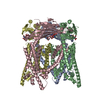
|
|---|---|
| 1 |
|
- Components
Components
| #1: Protein | Mass: 65573.617 Da / Num. of mol.: 4 Source method: isolated from a genetically manipulated source Source: (gene. exp.)   Homo sapiens (human) / References: UniProt: Q99J21 Homo sapiens (human) / References: UniProt: Q99J21#2: Polysaccharide | 2-acetamido-2-deoxy-beta-D-glucopyranose-(1-4)-2-acetamido-2-deoxy-beta-D-glucopyranose Source method: isolated from a genetically manipulated source #3: Chemical | ChemComp-NA / | #4: Water | ChemComp-HOH / | Has ligand of interest | N | |
|---|
-Experimental details
-Experiment
| Experiment | Method: ELECTRON MICROSCOPY |
|---|---|
| EM experiment | Aggregation state: PARTICLE / 3D reconstruction method: single particle reconstruction |
- Sample preparation
Sample preparation
| Component | Name: Mouse Transient receptor potential-mucolipin 1 apo closed state Type: COMPLEX / Entity ID: #1 / Source: RECOMBINANT |
|---|---|
| Source (natural) | Organism:  |
| Source (recombinant) | Organism:  Homo sapiens (human) Homo sapiens (human) |
| Buffer solution | pH: 8 |
| Specimen | Embedding applied: NO / Shadowing applied: NO / Staining applied: NO / Vitrification applied: YES |
| Vitrification | Cryogen name: ETHANE |
- Electron microscopy imaging
Electron microscopy imaging
| Experimental equipment |  Model: Titan Krios / Image courtesy: FEI Company |
|---|---|
| Microscopy | Model: FEI TITAN KRIOS |
| Electron gun | Electron source:  FIELD EMISSION GUN / Accelerating voltage: 300 kV / Illumination mode: FLOOD BEAM FIELD EMISSION GUN / Accelerating voltage: 300 kV / Illumination mode: FLOOD BEAM |
| Electron lens | Mode: BRIGHT FIELD / Nominal defocus max: 2200 nm / Nominal defocus min: 900 nm |
| Image recording | Electron dose: 60 e/Å2 / Film or detector model: GATAN K3 (6k x 4k) |
- Processing
Processing
| CTF correction | Type: PHASE FLIPPING ONLY |
|---|---|
| 3D reconstruction | Resolution: 2.598 Å / Resolution method: FSC 0.143 CUT-OFF / Num. of particles: 33553 / Symmetry type: POINT |
 Movie
Movie Controller
Controller





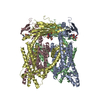
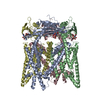
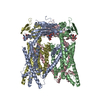
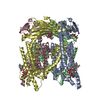


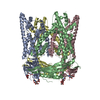
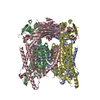

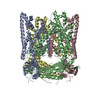
 PDBj
PDBj


